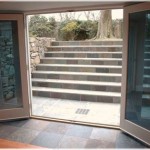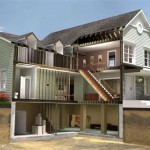Add an Egress Window to Your Basement: Essential Considerations
An egress window is a crucial safety feature that provides an emergency escape route from a basement in case of a fire or other hazardous event. Installing an egress window is not a DIY project and should be handled by qualified professionals. Here are the essential aspects to consider when adding an egress window to your basement:
1. Code Requirements
Egress windows must meet specific building codes to ensure proper functionality and safety. These codes vary by jurisdiction, so it is crucial to consult your local building department for specific requirements. Generally, egress windows should be a minimum of 24 inches wide and 36 inches high, with a minimum opening of 5.7 square feet.
2. Location and Placement
The location of the egress window is critical. It should be placed in a bedroom or habitable space serving as a sleeping area. The window should be easily accessible and unobstructed by furniture or other objects. Avoid placing the window too close to a furnace, water heater, or other potential hazards.
3. Type and Materials
Egress windows are typically made of either vinyl or aluminum. Vinyl windows are more affordable and energy-efficient, while aluminum windows are more durable and resistant to corrosion. The window frame should be made of a sturdy material that can withstand the elements and provide sufficient support for the window.
4. Window Well
An egress window requires a window well to provide a safe landing area in case of an escape. The window well must be at least 36 inches deep and 36 inches wide, with a ladder or steps for climbing out. The well should be covered with a grate to prevent debris and water from entering.
5. Installation
Egress window installation should be performed by experienced professionals who have the proper knowledge and equipment. Improper installation can compromise the safety and functionality of the window. The installers will cut an opening in the foundation wall, install the window frame, and secure the window in place. They will also create a window well and install a ladder or steps.
6. Inspection and Maintenance
Once installed, egress windows should be regularly inspected and maintained to ensure they are in good working order. Inspect the window for cracks, leaks, or damage. Check the window well for debris or water accumulation. Test the ladder or steps to ensure they are secure and easy to use. If any issues are found, contact a qualified professional for repairs or maintenance.
Conclusion
Adding an egress window to your basement is an essential safety precaution that can save lives in an emergency. By following these essential considerations, you can ensure that your egress window is installed properly, meets building codes, and provides a safe and reliable means of escape.

How To Install A Basement Egress Window Acculevel

Pros And Cons Of Egress Windows News Events For Thrasher Foundation Repair

How To Add An Egress Window Your Finished Basement

Smart Moves To Keep Your Basement Dry Tips And Tricks

Basement Egress Window Cost And Installing An

Installing Egress Windows Pros Cons Costs

What Features Do I Need In A Basement Egress Window Aaa Foundation Repair Wichita

What You Should Know About Walk Out Basement And Egress Window Construction

Basement Egress Window Cost And Installing An

How Much Value Does An Egress Window Add Home Inspection Geeks
Related Posts







